Summary:
The highly anticipated follow-up to Kate Atkinson's #1 bestseller Life After Life , "one of the best novels I've read this century" (Gillian Flynn). Kate Atkinson's new novel tells the story of Ursula Todd's beloved younger brother Teddy - would-be poet, RAF bomber pilot, husband, and father - as he navigates the perils and progress of the 20th century. For all Teddy endures in battle, his greatest challenge is facing the difficulties of living in a future he never expected to have. A GOD IN RUINS explores the loss of innocence, the fraught transition from the war to peace time, and the pain of being misunderstood, especially as we age.
My take: 2 looks
I was very eager to read this book. I LOVED "Life After Life" by Atkinson, recommending it to every reader I know. The author has described this, not as a sequel, but as a companion novel. It follows the life of Teddy, the much-loved sibling of "Life After Life" protagonist Ursula, as he grows from childhood to his eventual death.
I am going to try very hard to refrain from spoilers, but I also have to explain why this book is sorely lacking, especially after the brilliance of her last work.
First of all, it is extremely verbose. Three pages describe the drive down the lane to get to a manor house. Entire chapters are dedicated to Teddy's bombing experiences. While these experiences are vital to the man Teddy becomes, the level of detail for each and every one invites skimming. Teddy was out of the RAF at age 29,and lived almost 70 years more. I wanted more of that life. Describe how the war affected him, yes, but from the perspective of the older man. Instead, Atkinson describes the same time frame again and again.
The cast of characters around Teddy was rich: Hugh, Sylvie, and the Shawcross family during his youth; Nancy and Viola during the middling years; and finally Bertie and Sunny during older years. These were all fully flawed characters, and very real, but I thought it odd that Atkinson showed the reader only one or two sides. For example, Viola was extremely difficult to like throughout the book, and when Atkinson hinted at redemption, she withdrew and left the outcome lacking. Did she receive redemption, or no?
Another example is Nancy. She seemed very aloof with Teddy, from her wartimes experiences to her illness. Was this intentional, or did Atkinson simply see her as a one-dimensional character? She was very forthcoming with her sisters, but not her husband? Why all the secrecy behind her wartime efforts, despite her promise to Teddy to tell all after the war? Yes, we see that she felt as if she threw away her life, but is that all we get to her inner struggle? Character development was too abbreviated for me.
To end on a high note, I will say that I enjoyed the chapters which told of similar events from a different character's perspective. However, they were few and far between. I would have liked the book better if this had been more of the core concept, as opposed to the heavy-hand used during his RAF years. I also enjoyed the moments of stream-of-consciousness writing, going back and forth in time.
And to conclude: I felt the ending was a complete and total cop-out. It is not a plot twist, as some are wont to describe the heinous turn of events. I won't say more other than to completely chide Atkinson for this dereliction of an ending. What could have possibly been three looks becomes a fractured two, making this...
Not recommended.
Tuesday, June 30, 2015
Library Look: Book Vending Machines
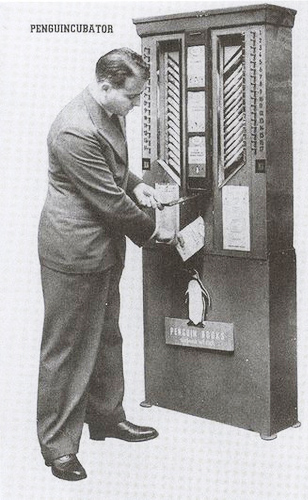
How hilarious is that name?? Saying it out loud makes me smile.
Did you know that the first machine for dispensing books was built in 1822? Richard Carlile of England was a reader and bookseller ahead of his time!
His motivation for building the machine was to sell copies of subversive publications like Thomas Payne's Age of Reason. Selling such items openly would most like get you tossed in jail during those days.
The machine pictured here came next, making the scene in 1937. The founder of Penguin Books, Allen Lane, conceived of the idea to operate in much the same way cigarette machines worked.
Going through several iterations over the decades, there are still book vending machines around today. They have the most popularity in larger European and Asian cities, but there are a few in the US.
The Fullerton Public Library, however, is taking it even further: the books are free. According to the Orange County Register:
The library is using a $35,000 federal grant to install the machine, which will include a drop box for returns and a selection of about 500 books for checking out.
"It's like a Redbox for books," said Maureen Gebelein, Fullerton's library director.
The vending machine, at no cost to the user, went into operation this week and offers hard-cover and paperback books in a variety of genres.
Most with an active Fullerton Public Library card will be able to use the vending machine; if you owe $5 or more on your library card, you will not be able to check out books from the machine.
The books in the machine this week are all best sellers. The plan is to monitor what books in the machine are most popular and to stock those types.
My favorite book vending machine, however, is the home-made Monkey's Paw Biblio-Mat. You put in $2 and get a randomly selected second hand book. Heaven!!
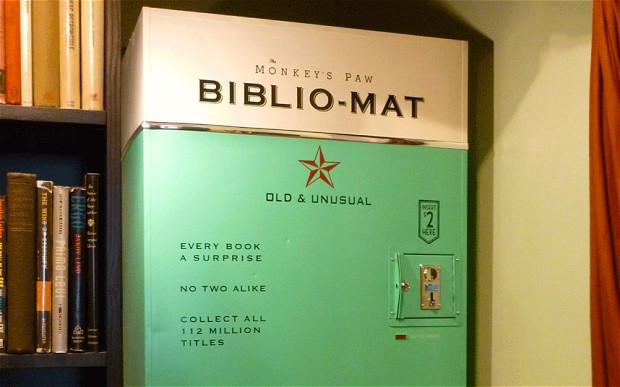
Wednesday, June 24, 2015
Wednesday Word: Pregnant
preg·nant
ˈpreɡnənt/
adjective
adjective: pregnant
- 1.(of a woman or female animal) having a child or young developing in the uterus."a pregnant woman"
- 2.full of meaning; significant or suggestive."a pregnant pause"
synonyms: full of, filled with, charged with, heavy with, fraught with, replete with, rich in, abounding in
My grandmother used this word quite a bit when I came to her with an idea. "That is a pregnant idea!" she would exclaim! I thought this was so funny, and I came to love this usage of the word. The word "pregnant" is full of meaning and conjures quite a full, robust mental image. I think it would be a pregnant idea to use this word more often!
Tuesday, June 23, 2015
Library Look: Weapon of Mass Instruction
 How cool is this picture? This is the Weapon of Mass Instruction, and
How cool is this picture? This is the Weapon of Mass Instruction, and is seriously "a thing".
Courtesy of a converted 1979 Ford Falcon, Buenos Aires artist Paul Lemesoff has created a tank-like vehicle, complete with non-functioning gun, to combat ignorance.
Called Arma de Instruccion Masiva, the tank can hold about 900 books, and they are free to anyone who would like one. The only stipulation is that you have to promise to read what you take.
7 UP made a video featuring this. Eccentric? Maybe. Crazy? Maybe. Brilliant? Definitely!!
Ellen Foster by Kaye Gibbons

In Ellen Foster, the title character is an 11-year-old orphan who refers to herself as "old Ellen," an appellation that is disturbingly apt. Ellen is an old woman in a child's body; her frail, unhappy mother dies, her abusive father alternately neglects her and makes advances on her, and she is shuttled from one uncaring relative's home to another before she finally takes matters into her own hands and finds herself a place to belong.
My take: 3 looks
Ellen Foster is a very likable character, and one who is quite spirited. I enjoyed the writing style of using the voice of a young girl, complete with incorrect word usage (romantic fever vs. rheumatic fever) and incorrect grammar. It felt very authentic.
The transition between past and present was a little confusing for me at first, but once I found the rhythm, I was able to settle into it. It proved to be another nice way to tell the story, like Ellen was reflecting on her past.
Ellen's struggle with the various abuses of the adults around her was handled well. Gibbons was able to convey the seriousness of the situations without making the reader cringe. The wit and wisdom in how young Ellen responds to the dangers around her was a welcome respite for me, as opposed to the more raw "Bastard Out of Carolina" by Dorothy Allison. To me, this made the book much more YA-friendly.
Ellen's friendship with Starletta, a black student at her school, was an important theme, but I didn't see it quite as central and pivotal as was apparent at the end of the book. I found it an odd way to end this story, since there were so many other relationships that seemed to be more important.
Overall, this was an easy book to read. It is very short, at less than 150 pages, and Ellen's outlook is hopeful throughout her troubles. I would recommend.
Saturday, June 20, 2015
The Little Prince by Antoine de Saint-Exupery
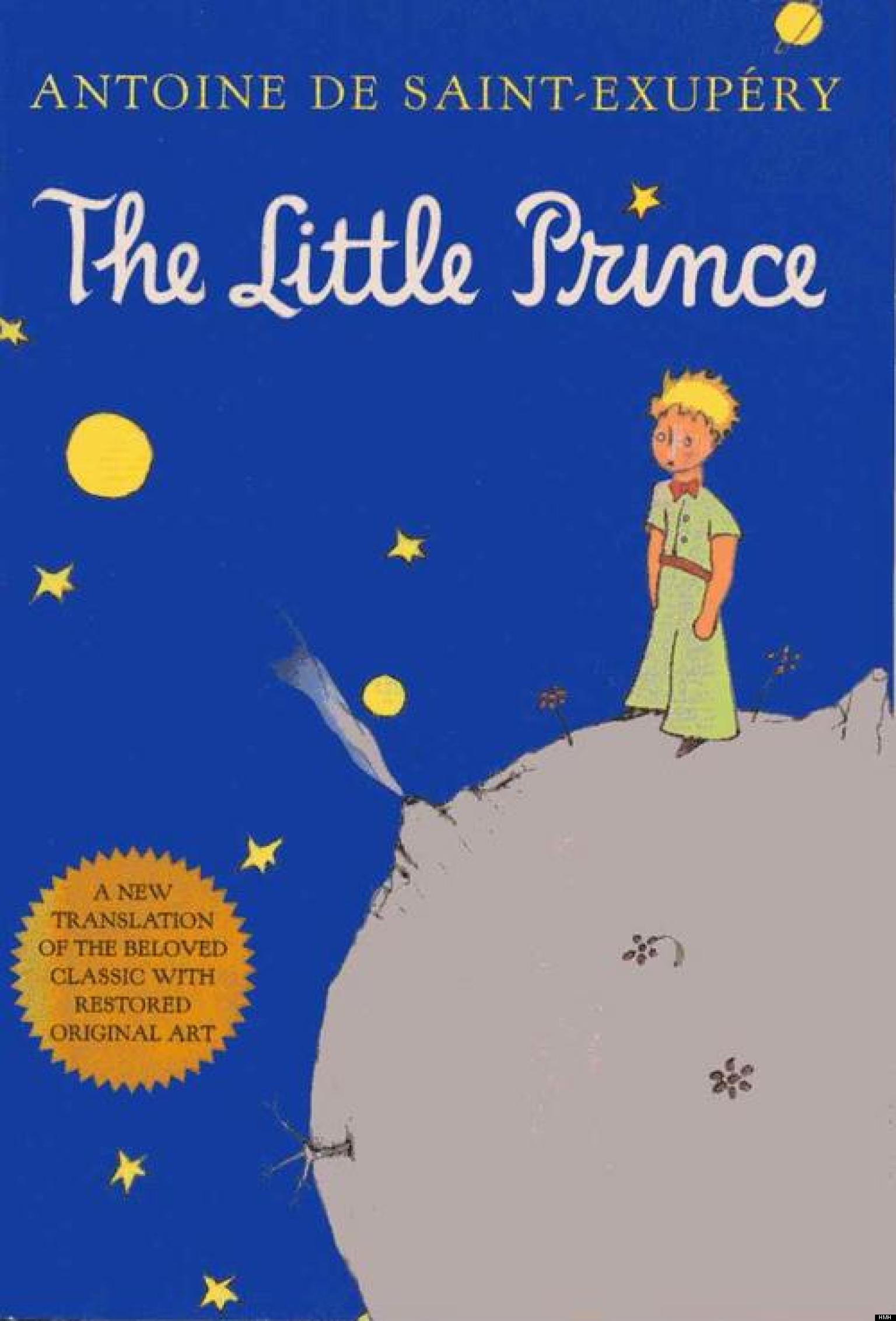
Few stories are as widely read and as universally cherished by children and adults alike. Richard Howard's new translation of the beloved classic-published to commemorate the 100th anniversary of Antoine de Saint-Exupery's birth-beautifully reflects Saint-Exupery's unique and gifted style. Howard, an acclaimed poet and one of the preeminent translators of our time, has excelled in bringing the English text as close as possible to the French, in language, style, and most importantly, spirit. The artwork in this new edition has been restored to match in detail and in color Saint-Exupery's original artwork.
My take: 5 looks
Wonderful! Why I have waited so long to read this book ... well, there is no good answer.
It is the perfect book for children. It tells a cute story of a tiny boy visiting planets and learning about them. His adventurous spirit and inquisitive nature will be right at home with little ones. It is also the perfect book for adults, with rich metaphors that will make you think, reflect, and consider so many instilled perceptions.
The unnamed narrator is in a state of wonder as he puts pen to paper for this story, still clearly besotted by this little boy and his meeting some six years earlier. I was just as besotted. I plan to read this book again and again. It is one of those stories that will mean more and different things to the reader as age and experience take their place over the course of time.
Highly recommended to own, and to read!
The Mapmaker's Children by Sarah McCoy

When Sarah Brown, daughter of abolitionist John Brown, realizes that her artistic talents may be able to help save the lives of slaves fleeing north, she becomes one of the Underground Railroad’s leading mapmakers, taking her cues from the slave code quilts and hiding her maps within her paintings. She boldly embraces this calling after being told the shocking news that she can’t bear children, but as the country steers toward bloody civil war, Sarah faces difficult sacrifices that could put all she loves in peril.
Eden, a modern woman desperate to conceive a child with her husband, moves to an old house in the suburbs and discovers a porcelain head hidden in the root cellar—the remains of an Underground Railroad doll with an extraordinary past of secret messages, danger and deliverance.
My take: 4 looks
Any book which makes me guffaw or cry is an automatic 4 looks, and this one brought me to tears. But I am getting ahead of myself.
The book is based on a wonderful premise: the perspective of the Underground RR from Sarah, the daughter of John Brown. As the book opens, Sarah is a girl who quickly inserts herself into the cause. There are a number of characters you will recognize, like mentions of Louisa May Alcott and Henry David Thoreau. Sarah is completely committed to abolish slavery, and dedicates her life to it.
Parallel to the story of the UGRR is the modern-day story of Eden, who has moved with her husband Jack from their busy lives in the city to a more rural area to alleviate stress. Eden struggles with infertility and it affects her entire existence. Her almost-eleven-year-old neighbor, Cloe, brings much needed grounding to the aggrieved Eden.
And that is all I will tell you of the story. Instead, let me explain why this book gets 4 looks from me. First of all, I am not a fan of the writing style of two parallel stories in time. I find that I am usually drawn to one story over the other, and start almost skimming the lesser storyline to get to the more compelling one. Not the case here. I was fully invested in both Sarah and Eden's stories. Each chapter went back and forth, and each provided a significant and satisfying part to that story before moving on to the next. The supporting characters were richly depicted and they added much to both stories.
The other item I found strong was the portrayal of Eden's struggle to have a baby. I have read a few reviews that Eden was a bit over-the-top; however, I can tell you from watching my best friend go through the same thing that this portrayal was so accurate that it almost hurt me to read, another sign of a great storyteller. Fertility does take over a woman's life if she is unable to conceive. To see new mothers and hear the laughter of children is heartbreaking each and every time, and I give kudos to McCoy for bringing this to her pages. I felt Eden's pain.
Finally, when the parallel stories started to weave together, it was delightful. There was a tendril here, a creeping vine there, and before I knew it, the two stories became a wonderfully covered arbor. The way the characters from the past colored and imbued the future brought smile after smile to my face as I read. I was entranced.
And I won't tell you why I cried, or which storyline elicited it. I will only tell you this: read this book!
I received this book from the Blogging for Books program in exchange for this honest review.
Wednesday, June 17, 2015
The Traveling Death and Resurrection Show by Ariel Gore
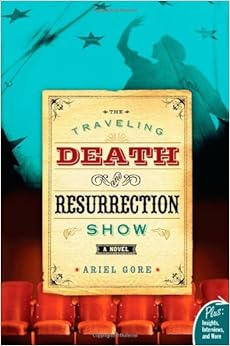
Orphaned at age four and raised by her black-clad, rosary-mumbling, preoccupied grandmother, Frankka discovered the ability to perform the stigmata as a way to attract her grandmother's attention. Now twenty-eight, Frankka's still using this extraordinary talent, crisscrossing the country with "The Death and Resurrection Show," a Catholic-themed traveling freak show and cast of misfits who have quickly become her new family. But when a reporter from the Los Angeles Times shows up to review the show, Frankka finds herself on the front page of the newspaper -- the unwitting center of a religious debate. Now unsure of who she is and where she belongs, Frankka disappears in search of herself and a place to call home.
My take: 3 looks
The fact that Frankka is able to spontaneously display the stigmata is interesting enough for a book; the fact that she uses extreme hunger to manifest it is even better; but, that she does it as part of a traveling troupe makes it darn near impossible NOT to read.
There are several interesting aspects to the way the book is written. First of all, the first page of each chapter has a statue of a saint at the top of the page. While I was able to identify some and not others, I found myself wondering if the saint used at the beginning of the chapter related to the content of that chapter. In addition, some of the status are facing the reader and some are turned so that their backs face the reader. I also found this interesting.
Secondly, Frankka writes lovely stories about saints. After cross-referencing a few of these, I found them to be accurate, complete with interesting facts found only after looking at several reference sites. The stories are written in a notebook which she misplaces in her journeys, but she continues to write the stories on scrap pieces of paper and napkins.
Other members of the troupe are interesting, but are by no means a main part of the story. This is all about Frankka and her journey.
Favorite quotes:
- Sometimes it is right to battle death, but sometimes death has its reasons. p60
- I hate it when that happens -- when something that seemed to important just a few days or hours earlier suddenly loses its meaning. p176
An enjoyable and recommended summer read.
Wednesday Word: Fisticuffs
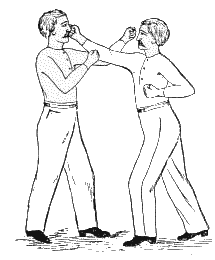
fist·i·cuffs
ˈfistiˌkəfs/
noun
plural noun: fisticuffs
- fighting with the fists.
I LOVE this word! You can certainly say many other common words in its place, like "it came to blows", "they started fighting", "he hit the other man". However, nothing really captures the feel of the moment more than saying, "It finally came to fisticuffs!" See? Don't you love this??
Tuesday, June 16, 2015
Library Look: The Topeka and Shawnee County Public Library
How fun can I library be? They can product a video parody of Taylor Swift's Shake it Off, THAT'S how fun they can be!!
Not only are the librarians hipster-cool, so are the offerings in this library. The current facility boasts a community center, meeting facility, café, art gallery and hub for learning. The expansion of the library, designed by renowned architect Michael Graves, is family friendly and hosts a full calendar of events.
This kind of library truly makes a trip to the library an adventure!
Die Trying by Lee Child

A Chicago street in bright sunshine. Jack Reacher, strolling nowhere, meets an attractive young woman, limping, struggling with her crutches, alone. Naturally he stops to offer her a steadying arm, and then they turn together - to face twin handguns held level and motionless and aimed straight at their stomachs.
Chained to the woman, locked in a dark, stifling van racing 2,000 miles across America, Reacher needs to know who he's dealing with. The kidnappers are saying nothing and his companion claims to be Holly Johnston, FBI agent. She's fierce enough and tough enough, but he knows there must be more to her than that. And at their remote, hostile destination, they will need to act as a team and trust each other, pitting raw courage and cunning against insane violence and seemingly hopeless odds, with their own lives and hundreds more at stake.
My take: 2.5 looks
Normally I love a good Jack Reacher novel, but this one was slow-moving and more ... emotional than the others I have read. While it's true that I have read them out of order, this is a very different Jack Reacher than in later novels. But I am getting ahead of myself.
The story revolves around the kidnapping of one woman on purpose, and Jack by accident. The woman is an FBI employee, who constantly whines about being the daughter of a high-ranking government official. The militants who capture them are seriously crazy, and at least one has a very dark streak.
Like other Reacher novels, it is full of fighting, figuring, weapons, and pretty straightforward. What I didn't like about this one was it was a bit long in the tooth. I felt that it could have been edited down to be more succinct. Also, the FBI Agent's whining got thin quickly. And Jack was so much more emotional. His line of questioning on whether or not his fellow captive had a boyfriend was shockingly out of character.
All-in-all, while this was a fast read, I can't recommend it as one of the better Reacher novels.
Saturday, June 13, 2015
Empire Falls by Richard Russo
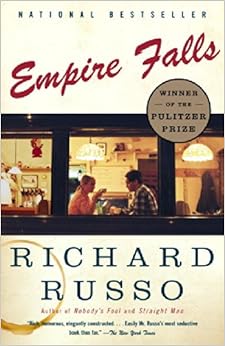
With Empire Falls Richard Russo cements his reputation as one of America’s most compelling and compassionate storytellers. Miles Roby has been slinging burgers at the Empire Grill for 20 years, a job that cost him his college education and much of his self-respect. What keeps him there? It could be his bright, sensitive daughter Tick, who needs all his help surviving the local high school. Or maybe it’s Janine, Miles’ soon-to-be ex-wife, who’s taken up with a noxiously vain health-club proprietor. Or perhaps it’s the imperious Francine Whiting, who owns everything in town–and seems to believe that “everything” includes Miles himself. In Empire Falls Richard Russo delves deep into the blue-collar heart of America in a work that overflows with hilarity, heartache, and grace.
My take: 4 looks
Winner of the Pulitzer Prize for Fiction in 2002, this book got off to a slow start for me. However, as the story continued, I found that I could not put it down.
Set in a depressed area, where textile manufacturing was once king, the town is now a shell of what it used to be, with one matriarch running the show, and not always benevolently. The protagonist, Miles, is a very likable guy, even if he's a little bit of a milquetoast. His father is hella irritating until the end, his ex-wife is irritating until the end, and the other supporting characters are the same: very real, flawed, and yet exceptional at the same time.
I loved the flow of the story. This is a depiction of real life. Miles' mother wants so much more for her son, and yet there is something about Empire Falls that draws him back. She herself has suffered a lost love, before she even had it. In turn, he wants so much for his daughter, and yet ... will she escape her hometown? Miles, too, suffers from the cruelest kind of love: unrequited. What exactly is the hold old Mrs. Whiting has on everyone? Does she have any other emotion rather than vengeance?
A lovely story of middle-America, with characters who are so real that you can pinpoint them in your own family. A wonderful, wonderful recommendation.
Wednesday, June 10, 2015
Wednesday Word: Indelible
in·del·i·ble
inˈdeləb(ə)l/

adjective
adjective: indelible
- (of ink or a pen) making marks that cannot be removed.
synonyms: ineradicable, permanent, lasting, ingrained, persisting, enduring, unfading, unforgettable, haunting, never to be forgotten "indelible memories"- not able to be forgotten or removed."his story made an indelible impression on me"
synonyms: ineradicable, permanent, lasting, ingrained, persisting, enduring, unfading, unforgettable, haunting, never to be forgotten "indelible memories"
I remember a story of Estee Lauder visiting one of her makeup counters and overhearing a customer asking a sales associate how long a lipstick would wear. The associate told the customer that it was practically indelible. Ms. Lauder interrupted, and corrected her. "If it were indelible, my dear, I would never sell more."
I love this word. It is so clear in its meaning, yet very rarely used. Make it an indelible part of your vocab today!
Tuesday, June 9, 2015
The Book of Aron by Jim Shepard

From the hugely acclaimed National Book Award finalist, a novel that will join the shortlist of classics about the Holocaust and the children caught up in it. Aron, the narrator, is an engaging if peculiar young boy whose family is driven from the countryside into the Warsaw Ghetto. As his family is slowly stripped away from him, Aron and a handful of boys and girls risk their lives, smuggling and trading things through the "quarantine walls" to keep their people alive, hunted all the while by blackmailers and by Jewish, Polish, and German police (not to mention the Gestapo). Eventually Aron is "rescued" by Janusz Korczak, a Jewish-Polish doctor and advocate of children's rights famous throughout prewar Europe who, once the Nazis swept in, was put in charge of the ghetto orphanage. In the end, of course, he and his staff and all the children are put on a train to Treblinka, but has Aron managed to escape, to spread word about the atrocities, as Korczak hoped he would?
My take: 2 looks
The buzz on this book was so great that I downloaded it almost the day it was released. It is more of a novella, at 166 pages on my e-reader. Honestly, if it had been much longer, I would not have finished it.
I have several issues with the story. First of all, I have to question the reason it was written. It has been done before, by many, by those who actually experienced it. If Shepard wanted to tell how the Holocaust affected a young person, we have The Diary of Anne Frank. If he wanted to present real life in the Warsaw ghetto, we have The Diary of Mary Berg. If he wanted to present it in a novel form, we have Jacob the Liar. Something for children, maybe? There is Milkweed.
So, you see, if you write a book about life for a Jew during the second world war, you'd better bring something new to the table. Shepard doesn't, in my opinion.
The story is told first-person from the point of view of Aron, not yet a teen when the Warsaw ghetto is sectioned off. Because of this, I assume, the narrative is very disjointed and fragmented. Ideas and descriptions are left hanging, and there are rather abrupt changes in flow and subject. In giving the author the benefit of the doubt, I would say that this is the way a boy in the ghetto would think. However, it would have been more effective if there had been a flow in the beginning, loosening and losing structure as Aron is affected by his circumstances.
There were many superfluous items in the story that were never fully developed. Why was his relationship with his father strained? Did his father treat all of the children that way, or just Aron? What became of Boris and his desire to kill Aron? What was the profound effect that must have existed because of Aron's forced friendship with Lejkin?
There are so many wonderful books which cover this tragic time in history. I cannot recommend this one.
Library Look: Suzzallo & Allen Libraries
I read an article recently about the incorporation of fine art in libraries. Evidently, some believe that libraries are for books only, and pieces of art should be relegated to museums.
I found this very interesting, and started to do a little research.
Read an interesting story here about the library in Long Beach removing a controversial doll exhibit earlier this year. R. Bruce Flowers' sculpture is shown behind a curtain at the Tillsonburg Library in Ontario. These are only two examples of many.
The point is clear: libraries are the perfect place for art! Where else should a dialogue start and proceed about a particular topic. Who else better to keep the flame of censorship quelched than a librarian?
 With that in mind, I present the Suzzallo & Allen Libraries, located at the University of Washington. Outside the impressive structure are eighteen terra-cotta figures in niches atop buttresses, which were selected by the UW faculty in 1923 to symbolize contributions to learning and culture.
With that in mind, I present the Suzzallo & Allen Libraries, located at the University of Washington. Outside the impressive structure are eighteen terra-cotta figures in niches atop buttresses, which were selected by the UW faculty in 1923 to symbolize contributions to learning and culture.The Grand Stair Hall houses one of the world's biggest books, a series of photographs of Bhutan by Michael Hawley. Protected by light-safe glass, the book’s pages are turned about once a month by Library staff.
At each end of the reading room, hangs a hand-painted world globe, each of which bear names of explorers. In the south apse, Leif Ericson, Marco Polo, Columbus, Amerigo Vespucci, Magellan, Henry Hudson, Vasco da Gama and Juan Rodriguez Cabrillo. In the north apse, Ponce de Léon, Hernando Cortez, Capt. John Smith, Sir Walter Raleigh, Fray Junípero Serra, Vasco Núñez de Balboa, Francisco Pizarro, John Cabot, Jacques Cartier and Fernando de Soto.

In 1994, artists Carl T. Chew, Mare Blocker, J. T. Stewart, and Ron Hilbert installed their collaborative artwork, Raven Brings Light to This House of Stories in the Allen Library as part of the Washington State Art in Public Places Program.
This library is impressive online. I can't imagine what it's like in person!
Sunday, June 7, 2015
The Catch by Taylor Stevens

Vanessa Michael Munroe, chameleon and information hunter, has a reputation for getting things done—often dangerous and not quite legal things. With blood on her hands and a soul stained with guilt, Munroe has fled to Djibouti, Africa. There, with no responsibility except a gig at a small maritime security company, Munroe finds stillness—until she’s pressured to work as an armed guard on a ship bound for Kenya. On board, Munroe discovers the contract is merely cover for gunrunning; when the ship is invaded off the Somali coast, she fights her way out—dragging the unconscious captain with her. But nothing about the hijacking is what it seems. The pirates had come for the captain, and continuing their pursuit, they unwittingly raise the killer’s instinct Munroe has tried so hard to bury. Wounded and on the run, Vanessa Michael Munroe will use the life of her catch as bait and bartering chip to manipulate every player, and wash her conscience clean.
My take: 3 looks
My feelings on this are a bit mixed. The is not the first in a series, but it is the first I have read. With that said, it may be that I am missing important information from the first book, but this one read well enough as a stand-alone.
The story is very fast moving. The premise that a ship has been hijacked by pirates off the coast of Africa is timely, but I got bogged down in the multiple locations, interjection of local language terms, and detail on the various interests and machinations of the various characters. The protagonist, Michael, is an androgynous badass. I say androgynous because no one she comes in contact with can tell she is a woman, unless she is wearing a skirt. Her bone structure, voice, or hair must be a giveaway. However, when it works to her advantage, she must be very feminine.
The other main characters are very shallow and one-dimensional. Leo is Michael's first boss, who double crosses her. Amber Marie is his girl. Adbi is a businessman and money launderer, Victor is a good guy who befriends Michael in the beginning. There are numerous other characters who are just as shallow and poorly drawn as these. For example, why is there so much animosity between Michael and Leo? What on earth is going on with Michael's feelings for Amber? I got the distinct feel of a homoerotic undertone here. Why does Michael feel such an affinity for Victor? Does she really so badly need someone to be nice to her? Is that all she owes him?
On top of the one-dimensional characters, I was extremely put off by the over-the-top bravado. A couple of examples:
- The rifle discharged beside her ear, deafening, while the young man fought for control and her knife answered with a life of its own, the dormant demons ascending from deep sleep, instinct and speed in the face of death.
- Her kills her primal, instinct that overrode logic and morality, blood and violence made flesh in the rage-induced defense of herself or another, a visceral reaction from the animal brain of the cut and bleeding girl she'd once been, the animal brain that took control and refused to die.
These are two of the more eye-rolling passages, but the book is laden with them.
While these were two issues that very much limited my enjoyment of the book, it was an easy book to read, and was fast-paced. The storyline was a little convoluted, but the action was compelling. That is what makes me give three looks instead of anything lower.
However, at the end of it all, I was not really sure what the purpose was. Did Michael get what she wanted? Did Abdi get his part of the deal? Was Leo as smarmy as he appeared? Did Amber get out of debt?
But the real question I can answer: Do I really care? Not really.
Thank you to BloggingForBooks.com for a copy of this novel for an honest review.
Wednesday, June 3, 2015
Wednesday Word: Pariah
pa·ri·ah

pəˈrīə
noun
noun: pariah; plural noun: pariahs
- an outcast; a person who is hated and rejected by other people"they were treated as social pariahs"
- historicala member of a low caste in southern India.
1610s, from Portuguese paria or directly from Tamil paraiyar, plural of paraiyan "drummer" (at festivals, the hereditary duty of members of the largest of the lower castes of southern India), from parai "large festival drum." Applied by Hindus and Europeans to any members of low Hindu castes and even to outcastes. Extended meaning "social outcast" is first attested 1819. Online Etymology Dictionary
I write an article once a month for the local newspaper. Topics vary, but it's always an opinion piece. Since I live in a very small town in the deep south, my opinions are very often at odds with my neighbors. Because of this, I find that I am often a pariah.
Tuesday, June 2, 2015
Library Look: Westbury Book Exchange

How stinking cute is this? The only smaller library I can think of is the Little Free Library, which is coming soon on Library Look.
This book exchange started because residents in Westbury became frustrated with the lack of library services in their area. The former BT phone kiosk has been transformed from a telephone exchange to Britain's smallest library by cunning residents and now stocks around 100 titles.
The phone box library is open every day for 24 hours and is lit at night. There is a regular check on it to see if some titles are not moving. These are then shipped on to a charity shop to keep the phone box collection fresh.
Plus it has started a trend! BT has received 770 applications for communities to 'adopt a kiosk' and so far 350 old boxes have been handed to parish councils.
Monday, June 1, 2015
Paper vs. E-Reader

Libraries first introduced free e-books in 1998, and it has been going strong ever since. However, personal libraries of physical books continue to grow, as well. Not only are people still buying physical books, many buy several editions of the same book for their collections.
For example, I currently have "To Kill a Mockingbird" by Harper Lee in paperback, hardcover, and I just recently purchased a UK edition. When I visit Monroeville, home to Lee, I will probably purchase another copy there, simply to have one that was purchased in her hometown. That is four of the same book, but different versions.
 I recently saw a pic of a bibliophile's "Alice in Wonderland" collection. Books and books and books of one central story. Now, she may have a electronic copy of this book on her reader, but the sheer pleasure of developing such a collection of books based on one story ... well, there is nothing else like it! Nothing else compares, and only another crazed-book-lover would totally and completely understand.
I recently saw a pic of a bibliophile's "Alice in Wonderland" collection. Books and books and books of one central story. Now, she may have a electronic copy of this book on her reader, but the sheer pleasure of developing such a collection of books based on one story ... well, there is nothing else like it! Nothing else compares, and only another crazed-book-lover would totally and completely understand.The other reason I think the book vs e-reader debate is finally becoming a non-issue is the movement from "the reader" to "the collector" of books. There are vast numbers of collections out there over which book lovers drool. Here are just a few:
Drop Caps by Penguin
Designer Collection of Modern Classics by Virago
Anything (and everything!) by Juniper Books
The First Ten Penguins by Penguin
And then, there are the sets. Like The Hardy Boys, Nancy Drew, Lord of the Rings, Chronicles of Narnia...There is virtually no end to these "must haves" for home libraries. I am currently collecting books which have won the Pulitzer Prize for Fiction.
So, while book sales may have dropped for new releases, I think publishers and booksellers have found a way to diversify and entice more shoppers. It's a savvy market which can sell someone something they already have!
Subscribe to:
Comments (Atom)
